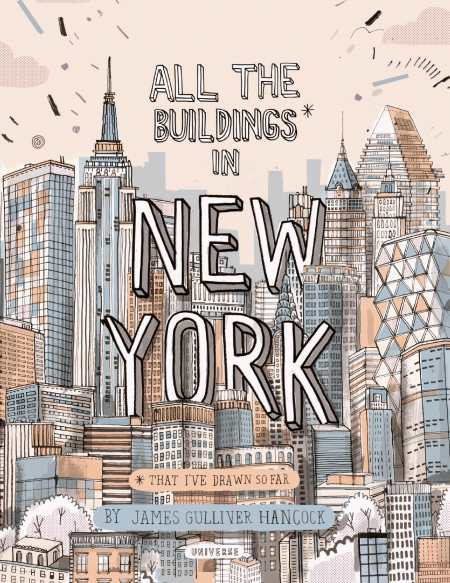
All the Buildings* in New York
*That I've Drawn So Far
Artist and illustrator James Gulliver Hancock’s affection for New York City is evident in every line he’s put to paper in composing All the Buildings* in New York *That I’ve Drawn So Far. The transplant from Sydney, Australia, introduces his collection—a self-proclaimed obsession—with the admission that he’s been around the block in a few other places before, having also lived in London, Los Angeles, Vienna, Berlin, Paris, Montreal, and Indonesia.
And while he’s also recorded aspects of those places, drawing such an iconic part of his new hometown has, he says, “become an almost ritualistic undertaking, a therapy of sorts, helping me to organize the overwhelming infinity and chaos of New York into something I can know and understand … Now I find myself running into the buildings I’ve drawn and greeting them like old friends.” Indeed, those with a New York affiliation will feel the same way looking at his art.
With a focus largely on Manhattan—and split between the exteriors of landmark structures like Grand Central Terminal, The Metropolitan Museum of Art, and The Plaza Hotel and some anonymous yet charming old brownstones—Gulliver takes his readers on an architectural tour of the island, from Wall Street to Harlem, stopping to consider “all the windows, all the chimneys, all the pipes, and even all the spiderwebs between the pipes” of the buildings that attract him. Beyond Manhattan, the Brooklyn Bridge, Coney Island, and the New York Botanical Garden (in the Bronx) also get some ink. Each linear composition is enhanced with two or three accent colors to bring out its prime features, i.e., the stained glass windows of St. Patrick’s Cathedral are rendered in a blue tone that contrasts with the gray wash illuminating the stone facade.
Unlike on the book’s cover, where a vibrant Midtown cityscape conveys some of Manhattan’s chaotic energy through its juxtaposition of so many buildings of different eras, each interior page features just one or two drawings of structures in the same neighborhood. While New Yorkers will fill in the surroundings and add to them from personal experience—instantly recognizing the site of a break-up, or another of an extraordinary discovery—the uninitiated may view Hancock’s inventory of isolated objects more like his personal diary. He includes addresses for each building, names them when appropriate, and notes a significant architect or historical occurrence for some, but his visual account is largely without context. Especially since the swift disappearance of The World Trade Center, the sense of dislocation among parts intended to keep each other in line is actually a little disturbing.
Nonetheless, Hancock’s lovely visual chronicle of a beloved landscape is a welcome contribution to the accretion of layers that continue to make up this multifaceted place. For a sneak peek, see allthebuildingsinnewyork.com.
Reviewed by
Julie Eakin
Disclosure: This article is not an endorsement, but a review. The publisher of this book provided free copies of the book to have their book reviewed by a professional reviewer. No fee was paid by the publisher for this review. Foreword Reviews only recommends books that we love. Foreword Magazine, Inc. is disclosing this in accordance with the Federal Trade Commission’s 16 CFR, Part 255.
